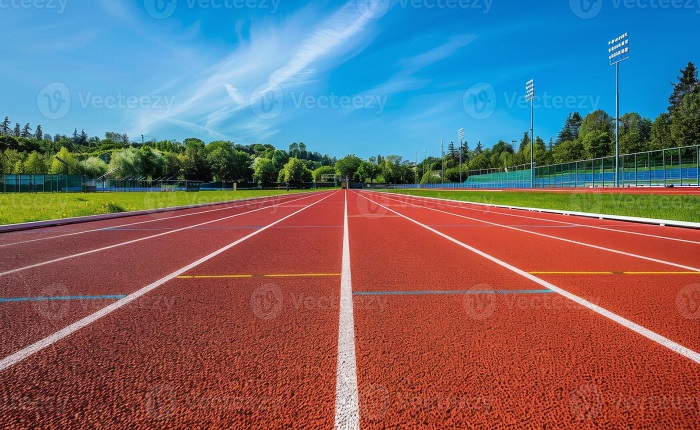The Essential Guide to the Sports Track: Unveiling its Benefits and Role in Athletics

The “sports track” is one of the most fundamental features in the world of athletics. Whether you’re training for sprints, marathons, or general fitness, the sports track provides an optimal surface for running and training. The design and construction of a sports track are crucial in supporting athlete performance and minimizing injuries. This blog will explore every aspect of the sports track, from its history to its modern-day importance, and answer some common questions.
What is a Sports Track?
A sports track, often found in athletic stadiums or public parks, is a specially designed surface where athletes can run, jog, or walk. It is typically oval-shaped and consists of several lanes. The sports track is built with high-quality materials to reduce the risk of injury while improving athlete performance. The keyword “sports track” is integral to understanding modern athletics as it has become the standard for training and competitions.
The History of the Sports Track
The sports track has a long history that dates back to ancient times. The first organized sports events, like the ancient Olympic Games, were held on dirt or grass tracks. As sports evolved, so did the design of the sports track. The introduction of synthetic materials in the 1960s marked a turning point in how tracks were built, making them more durable and athlete-friendly. The modern sports track is a result of years of engineering and design improvements that ensure athletes can train in the best possible conditions.
Types of Sports Tracks
Not all sports tracks are created equal. The most common type is the synthetic sports track, made from materials like polyurethane or latex. These materials provide a balance between cushioning and firmness, which enhances performance while reducing the risk of injury. Another type is the grass sports track, commonly used in rural or less developed areas. While natural, grass tracks are less ideal for competitive sports due to their uneven surfaces. The sports track can also come in asphalt or cinder, though these are less common today.
The Design and Layout of a Sports Track
The design of a sports track follows strict international standards, particularly for competitions. A typical sports track is 400 meters in length and has eight to nine lanes. Each lane is marked clearly to ensure fair competition. The keyword “sports track” plays a crucial role in athletic competitions because the standardization of its layout ensures athletes from around the world can compete on an even playing field. Every aspect of the sports track, from the width of the lanes to the curvature of the turns, is designed to optimize performance.
Importance of a Well-Constructed Sports Track
The construction of a sports track directly affects the performance of athletes. A high-quality sports track offers a flat and consistent surface, which reduces the chances of tripping or stumbling. In addition, the material used in the sports track should have good shock absorption to protect athletes’ joints during high-impact activities. A well-maintained sports track can significantly reduce injury rates among runners, sprinters, and other athletes who rely on it for training and competition.
Benefits of Using a Sports Track
There are many benefits to using a sports track for athletic training. The surface of a sports track is designed to be smooth and consistent, allowing athletes to focus on their technique without worrying about obstacles. Moreover, the sports track provides a reliable environment for measuring performance, as it is standardized in length and width. Athletes can use the sports track to track their speed, endurance, and improvement over time. It also encourages a sense of discipline as athletes can easily measure progress by completing laps.
Materials Used in Sports Track Construction
A sports track is often made from synthetic materials like polyurethane, latex, or a mixture of both. These materials are chosen for their durability, resilience, and shock-absorbing qualities. The sports track surface needs to balance softness to reduce injury risk while being firm enough to support speed and performance. The synthetic nature of modern sports tracks allows for longer-lasting surfaces, even with frequent use. Maintenance also plays a key role in ensuring the longevity of the sports track.
The Science Behind Sports Track Surfaces
The surfaces of sports tracks are scientifically engineered to optimize athlete performance. The sports track’s composition ensures it has the right amount of friction and elasticity. Friction helps athletes maintain grip, while elasticity helps with energy return, which means runners can perform better by expending less energy. Modern advancements in sports track technology focus on creating surfaces that are both eco-friendly and high-performing, ensuring the sports track of the future will continue to support athletes at every level.
Training on a Sports Track vs. Other Surfaces
Many athletes prefer training on a sports track rather than on roads or uneven terrain. The keyword “sports track” becomes important here, as it provides an environment that is not only safer but also more controlled. While training on roads may expose athletes to varying conditions such as potholes, traffic, or inclines, a sports track offers consistency. This consistency is essential for measuring progress accurately, making the sports track the preferred surface for serious runners and athletes.
The Role of the Sports Track in Competitive Sports
The sports track is central to competitive sports, especially in events like the Olympics, World Championships, and other athletic meets. Track and field events rely on the sports track for sprints, hurdles, middle-distance running, and relays. The standardization of the sports track ensures that athletes can compete under the same conditions, no matter where they are in the world. The importance of the sports track in athletics cannot be overstated, as it plays a key role in both training and competitive performance.
Conclusion
The sports track is an indispensable part of athletics, providing athletes with a safe, reliable surface to train and compete on. Whether made from synthetic materials or natural grass, the sports track plays a pivotal role in supporting athletic performance. Its design and construction are essential in reducing injury risks and enhancing the experience for runners, sprinters, and other athletes. As technology continues to advance, we can expect the sports track to evolve, offering even more benefits to future generations of athletes.
FAQs
- What is the standard length of a sports track?
A standard sports track is 400 meters in length for a complete lap, commonly used in competitive athletics. - Why are sports tracks made from synthetic materials?
Synthetic materials like polyurethane are used in sports tracks because they provide durability, shock absorption, and consistency in performance. - Can beginners train on a sports track?
Yes, sports tracks are ideal for beginners because they offer a smooth, consistent surface that reduces the risk of injury and improves training efficiency. - How often should a sports track be maintained?
Sports tracks require regular maintenance, usually inspected every few months to check for wear and tear, and resurfacing may be needed every 8-10 years depending on use. - What is the main advantage of training on a sports track?
The primary advantage is the controlled environment, which ensures a smooth, even surface that allows athletes to focus on their training without external variables like uneven terrain.





